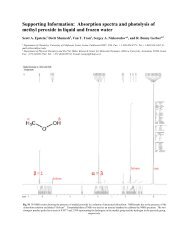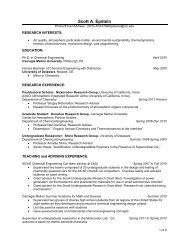194316-4 Nizkorodov et al. J. Chem. Phys. 122, 194316 2005FIG. 4. Survey action spectrum. The probe laser is tuned to <strong>the</strong> 2 − 3/2 8 rotational state <strong>of</strong> OHv=0, while <strong>the</strong> pump laser is scanned <strong>in</strong> frequency. The timedelay between <strong>the</strong> IR pump and UV photolysis laser is sufficiently long to allow all vibrationally exited complexes to predissociate. Apart from a few easilyidentifiable H 2 O monomer l<strong>in</strong>es, all <strong>the</strong> structure <strong>in</strong> <strong>the</strong> spectrum is due to Ar–H 2 O and H 2 O 2 . The bands labeled with asterisks almost certa<strong>in</strong>ly belong toAr–H 2 O but require fur<strong>the</strong>r studies for def<strong>in</strong>itive assignment.4. Indeed, some <strong>of</strong> <strong>the</strong>se bands display partially resolvedrotational structure consistent with <strong>the</strong> Ar–H 2 O b<strong>in</strong>ary complex.A significant number <strong>of</strong> bands <strong>in</strong> <strong>the</strong> spectrum rema<strong>in</strong>even if Ar is completely replaced by He <strong>in</strong> <strong>the</strong> carrier gasmixture. However, <strong>the</strong>ir signal <strong>in</strong>tensities are reduced because<strong>of</strong> much smaller cluster<strong>in</strong>g efficiency <strong>in</strong> pure He jets.S<strong>in</strong>ce He–H 2 O cluster<strong>in</strong>g is expected to be negligible underroom temperature stagnation conditions, <strong>the</strong>se can be assignedto overtone spectra <strong>of</strong> H 2 O n complexes Table I.To<strong>the</strong> best <strong>of</strong> our knowledge, this represents <strong>the</strong> first such overtonespectra for neutral H 2 O <strong>clusters</strong>, specifically made possibleby <strong>the</strong> enhanced sensitivity <strong>of</strong> vibrationally mediatedphotodissociation methods. Indeed, at least one <strong>of</strong> <strong>the</strong>sebands at 7193 cm −1 even exhibits partially resolved rotationalstructure characteristic <strong>of</strong> H 2 O dimer, to which wenext direct our attention.C. First overtone „v OH =2… spectra <strong>of</strong> H 2 O dimerVibrational assignment <strong>of</strong> <strong>the</strong> OH-stretch<strong>in</strong>g bands <strong>of</strong>H 2 O 2 has historically proven to be a challeng<strong>in</strong>g task, evenat <strong>the</strong> fundamental level. Indeed, <strong>the</strong> four OH-stretch<strong>in</strong>g fundamentalshave been reassigned several times and only moreTABLE I. Positions and assignments <strong>of</strong> <strong>the</strong> observed overtone bands <strong>of</strong>Ar–H 2 O and H 2 O n . Positions are accurate to with<strong>in</strong> 0.2 cm −1 . WhereasAr–H 2 O assignments are relatively certa<strong>in</strong>, H 2 O 2 assignments should beconsidered speculative and a source <strong>of</strong> stimulation for fur<strong>the</strong>r <strong>the</strong>oreticalefforts.Positions cm −1 Carrier Band shape Assignment7193 a H 2 O 2 02 + a or 1 f 1 b7218.45 b Ar–H 2 O 02 − 0 00 ←1 01 7230.05 c Ar–H 2 O 02 − 0 00 ←1 01 7240 b H 2 O 2 d Most likely 2 f 0 b7249.8 b H 2 O 2 d Most likely 2 f 0 b7263.7 a Ar–H 2 O 02 − 1 01 ←0 00 7275.0 b Ar–H 2 O 02 − 1 01 ←0 00 7282 a H 2 O 2 da Approximate band center.b Q-branch position.c Band orig<strong>in</strong> from fitt<strong>in</strong>g.d Poorly def<strong>in</strong>ed band shape.or less def<strong>in</strong>itively understood from recent cluster sizeselectivespectroscopic work <strong>of</strong> Huisken et al. 21 Table IIsummarizes <strong>the</strong> presently accepted assignments at <strong>the</strong> v OH=1 level. With two quanta <strong>of</strong> OH-stretch<strong>in</strong>g excitation, <strong>the</strong>overtone spectral region is certa<strong>in</strong> to be significantly morecomplex; for example, <strong>the</strong>re are as many as ten differentpossibilities to distribute <strong>the</strong>m among <strong>the</strong> four OH bonds <strong>in</strong>H 2 O 2 .Fortunately, <strong>the</strong>ory predicts only a few <strong>of</strong> <strong>the</strong>se comb<strong>in</strong>ationstates to be efficiently produced from <strong>the</strong> ground state<strong>of</strong> H 2 O 2 via direct overtone pump<strong>in</strong>g. Harmonicallycoupled anharmonic oscillator HCAO calculations byKjaergaard and co-workers 24,25 predict that <strong>the</strong> strongest OHovertone transitions <strong>in</strong> H 2 O 2 should be 02 − a , 2 f 0 b ,02 + a , and 1 f 1 b listed <strong>in</strong> <strong>the</strong> order <strong>of</strong> decreas<strong>in</strong>g transitionstrengths, where a, f, and b refer to proton acceptor, freeproton donor, and bound proton donor OH stretches, respectively.Calculations by Chaban and Gerber done at CC-VSCFlevel 22 predict a somewhat different order <strong>of</strong> <strong>in</strong>tensities:02 − a , 1 f 1 b , 2 f 0 b , 02 + a , but both studies agree that <strong>the</strong>sefour transitions should dom<strong>in</strong>ate <strong>the</strong> v OH =2 spectrum <strong>of</strong>H 2 O 2 . The strongest v OH =2 bands <strong>in</strong> <strong>the</strong> cyclic water trimerspectrum are predicted to be <strong>of</strong> <strong>the</strong> type 2 f 0 b by calculation<strong>of</strong> Ref. 24. Chaban and Gerber predict that transitions<strong>of</strong> 1 f 1 b and 0 f 2 b types should be just as strong.Figure 5 shows simulated low-resolution spectra <strong>of</strong> H 2 O 2TABLE II. Currently accepted gas-phase positions <strong>of</strong> H 2 O 2 stretch<strong>in</strong>g fundamentals.The positions are taken from Ref. 10 with 01 a + reassigned to0 f 1 b based on <strong>the</strong> results <strong>of</strong> Ref. 21. The 01 a + transition has only beenobserved <strong>in</strong> Ar matrices Ref. 26, where it is quite weak. Calculationssuggest that it should occur at around 3650 cm −1 <strong>in</strong> gas phase.Mode K←K Position cm −1 01 a−0 lower ←1 lower 3738.41 upper ←0 upper and 1 lower ←0 lower 37532 upper ←1 lower 37771 f 0 b 0 upper ←1 lower and 1 lower ←0 upper 3731.7+01 a Not observed3633 a0 f 1 b 0 upper ←1 lower and 1 lower ←0 upper 3601a Ar matrix.Downloaded 26 May 2005 to 128.200.198.26. Redistribution subject to AIP license or copyright, see http://jcp.aip.org/jcp/copyright.jsp
194316-5 <strong>Overtone</strong> <strong>spectroscopy</strong> <strong>of</strong> H 2 O <strong>clusters</strong> J. Chem. Phys. 122, 194316 2005FIG. 5. Predicted band positions and <strong>in</strong>tensities <strong>of</strong> v OH =2 bands <strong>of</strong> H 2 O 2 .a CC-VSCF calculation by Chaban and Gerber Ref. 22. b HCAO calculationby Sch<strong>of</strong>ield and Kjaergaard Ref. 25. For better representation <strong>of</strong><strong>in</strong>tegrated band <strong>in</strong>tensities, <strong>the</strong> transitions are convoluted over a Gaussianwith half-width at half-maximum HWHM=7 cm −1 .based on <strong>the</strong> prediction <strong>of</strong> Refs. 22, 24, and 25. Despite apromis<strong>in</strong>g concurrence <strong>in</strong> general <strong>the</strong>oretical predictions for<strong>the</strong> overtone <strong>in</strong>tensities, <strong>the</strong>se studies fail to agree on <strong>the</strong>more detailed relative frequency order<strong>in</strong>g <strong>of</strong> <strong>the</strong> H 2 O 2bands, mak<strong>in</strong>g spectroscopic assignment <strong>of</strong> <strong>the</strong> observedH 2 O n overtones quite difficult. The most significant disagreementappears to exist for <strong>the</strong> relative frequencies <strong>of</strong> <strong>the</strong>1 f 1 b and 2 f 0 b overtone bands <strong>in</strong> both <strong>the</strong> dimer andtrimer species.The analysis <strong>of</strong> <strong>the</strong> H 2 O n band centered at 7193 cm −1may help shed some light on this issue. At higher sensitivityand lower IR pump powers to avoid saturation, this bandclearly reveals a partially resolved rotational structure seeFig. 6, with a characteristic spac<strong>in</strong>g between adjacent l<strong>in</strong>es<strong>of</strong> roughly 0.4 cm −1 . Though not fully resolved, this isnever<strong>the</strong>less consistent with an a-type band for H 2 O 2 ,which is known to have a near-prolate symmetric top structurewith B0.2 cm −1 , 2,10,13,16 and is clearly <strong>in</strong>consistentwith any cluster larger than dimer. Simulations <strong>of</strong> this bandpr<strong>of</strong>ile us<strong>in</strong>g <strong>the</strong> fundamental spectroscopic constants forH 2 O 2 quickly reveals it to be composed <strong>of</strong> at least twooverlapp<strong>in</strong>g a-type transitions. Most relevantly to <strong>the</strong> abovediscussion, <strong>the</strong> pr<strong>of</strong>ile cannot be satisfactorily modeled withoverlapp<strong>in</strong>g b- orc-type transitions, s<strong>in</strong>ce such bands wouldbe dom<strong>in</strong>ated by prom<strong>in</strong>ent Q-branch features not observed<strong>in</strong> <strong>the</strong> experimental spectrum.This lack <strong>of</strong> strong Q-branch transitions rules out assignmentto <strong>the</strong> overtone vibration <strong>of</strong> <strong>the</strong> hydrogen bond accep-FIG. 6. A slow scan over <strong>the</strong> H 2 O 2 band at 7193 cm −1 . This band has apartially resolved rotational structure characteristic <strong>of</strong> a parallel transition <strong>in</strong>H 2 O 2 complex. The band is simulated as a superposition <strong>of</strong> three K=0←0 subbands with orig<strong>in</strong>s at 7192.5 cm −1 B 2 − subband; odd J: evenJ=3:6, 7191.3 cm −1 E subband; no alternation, 7193.3 cm −1 A 2 − subband;odd J: even J=6:3 with a l<strong>in</strong>ewidth <strong>of</strong> 0.25 cm −1 . The band orig<strong>in</strong>s are notuniquely determ<strong>in</strong>ed by <strong>the</strong> simulation, though a B0.2 cm −1 rotationalconstant for water dimer is clearly consistent with <strong>the</strong> observed structure.tor, 02 − a , s<strong>in</strong>ce this transition moment would be predom<strong>in</strong>antlyalong <strong>the</strong> b axis <strong>of</strong> H 2 O 2 . In support <strong>of</strong> this, Huangand Miller 10 only observe b-type transitions for <strong>the</strong> correspond<strong>in</strong>g01 − a fundamental <strong>in</strong> H 2 O dimer see Table II.Indeed, H 2 O dimer exhibits considerable perpendicularstructure <strong>in</strong> <strong>the</strong> 01 −a fundamental region due to i K=0 lower ←1 lower , ii K=1 upper ←0 upper /K=1 lower ←0 lower , andiii K=2 upper ←1 lower subbands, which are observed−18 cm −1 ,−3cm −1 , and −22 cm −1 away from <strong>the</strong> 01 − a bandorig<strong>in</strong>, respectively. By way <strong>of</strong> contrast, we do not observeadditional H 2 O 2 features <strong>in</strong> this spectral region out to atleast ±40 cm −1 away from <strong>the</strong> 7193 cm −1 band. In summary,both <strong>the</strong> 7193 cm −1 band shape as well as lack <strong>of</strong> H 2 O 2transitions <strong>in</strong> <strong>the</strong> vic<strong>in</strong>ity make assignment to 02 − a unlikely.In light <strong>of</strong> <strong>the</strong> a-type rotational contour, a more plausibleassignment for <strong>the</strong> 7193 cm −1 band is <strong>the</strong> 1 f 1 b vibrationcentered on <strong>the</strong> proton donor unit <strong>of</strong> H 2 O 2 . This vibrationalmotion promotes a dipole transition moment along <strong>the</strong> a axis<strong>of</strong> H 2 O 2 , which is more consistent with <strong>the</strong> observed bandpr<strong>of</strong>ile. In addition, <strong>the</strong>re is a strong similarity between <strong>the</strong>band observed here and <strong>the</strong> a-type transition pr<strong>of</strong>ile fromHuang and Miller, 10 which has been assigned to 0 f 1 b , 21i.e., one quantum <strong>of</strong> <strong>the</strong> bound OH stretch. Fur<strong>the</strong>rmore, <strong>the</strong>1 f 1 b vibration is predicted to be <strong>the</strong> second strongest OHstretch<strong>in</strong>govertone <strong>in</strong> H 2 O 2 by Chaban and Gerber 22 andexecutes a motion that correlates with <strong>the</strong> strong 02 − overtone<strong>in</strong> H 2 O monomer. Also, <strong>the</strong> 1 f 1 b vibrational prediction<strong>of</strong> 7110 cm −1 by Chaban and Gerber see Fig. 5 is <strong>in</strong>relatively good agreement with experiment. We note that <strong>the</strong>02 + a acceptor overtone is yet ano<strong>the</strong>r possibility for achiev<strong>in</strong>gsuch a strong a-type transition moment, with predictedband orig<strong>in</strong>s 7170 cm −1 Ref. 22 and 7200 cm −1 Ref. 25<strong>in</strong> even closer agreement with experiment; however, <strong>the</strong> predictedovertone <strong>in</strong>tensities are relatively weak <strong>in</strong> both sets <strong>of</strong><strong>the</strong>oretical calculations. 22,25 In this regard, however, it isworth remember<strong>in</strong>g <strong>the</strong> “action” nature <strong>of</strong> <strong>the</strong>se spectra, <strong>in</strong>tensities<strong>of</strong> which rely on vibrationally mediated UV photolysis<strong>of</strong> <strong>the</strong> result<strong>in</strong>g predissociated complex. For example,excitation <strong>of</strong> <strong>the</strong> symmetric 02 + a could well predissociatepreferentially <strong>in</strong>to H 2 O<strong>in</strong>v OH =1, which, <strong>in</strong> turn, photodissociatesefficiently at 193 nm to yield OH. We will return tothis po<strong>in</strong>t later <strong>in</strong> <strong>the</strong> discussion but stress <strong>the</strong> importance <strong>of</strong>vibrational overtone dynamics <strong>in</strong> <strong>in</strong>terpret<strong>in</strong>g <strong>the</strong> spectra.Clearly a predictive understand<strong>in</strong>g <strong>of</strong> overtone frequencies,<strong>in</strong>tensities, and dynamics <strong>in</strong> hydrogen-bonded systems rema<strong>in</strong>sa challeng<strong>in</strong>g area for future progress, which <strong>the</strong>present work hopes to fur<strong>the</strong>r stimulate.With a suggested assignment <strong>of</strong> <strong>the</strong> 7193 cm −1 bandstructure to ei<strong>the</strong>r 1 f 1 b or 02 + a , we next address whe<strong>the</strong>rone can reproduce <strong>the</strong> observed rotational pr<strong>of</strong>ile withknown spectroscopic constants <strong>of</strong> H 2 O 2 . Any a-type transition<strong>in</strong> H 2 O 2 can, <strong>in</strong> pr<strong>in</strong>ciple, exhibit complicated f<strong>in</strong>estructure because <strong>of</strong> <strong>the</strong> presence <strong>of</strong> five uncoolable nuclearsp<strong>in</strong> symmetry species, specifically three K=1←1 lower subbandsA − 2 ,E − ,B − 2 ; three K=0←0 upper subbands A − 2 ,E − ,B − 2 ;and three K=0←0 lower subbands A + 1 ,E + ,B + 1 . Note that <strong>the</strong>specified subband symmetries do not <strong>in</strong>clude rotational symmetriesunlike <strong>the</strong> labels shown <strong>in</strong> Fig. 2. For example, all<strong>of</strong> <strong>the</strong>se a-type subbands appear <strong>in</strong> close proximity to eachDownloaded 26 May 2005 to 128.200.198.26. Redistribution subject to AIP license or copyright, see http://jcp.aip.org/jcp/copyright.jsp





